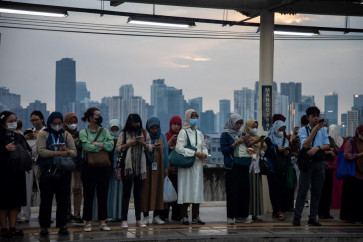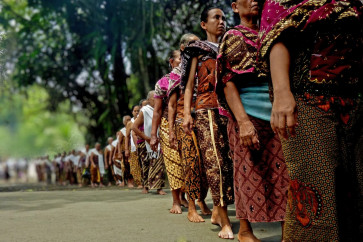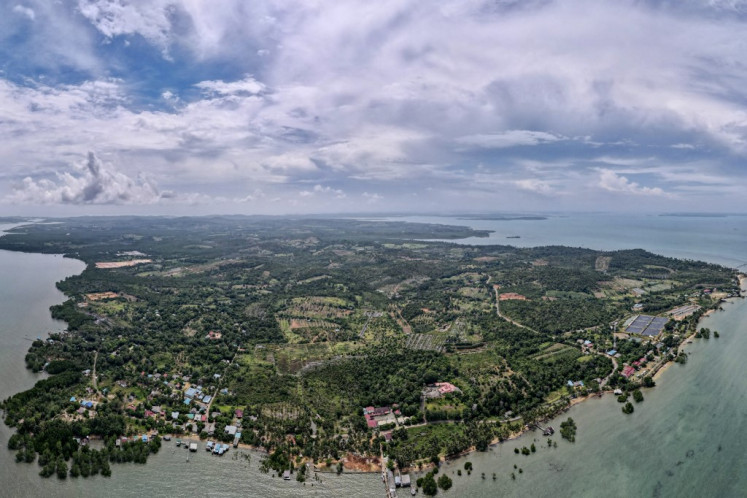Popular Reads
Top Results
Can't find what you're looking for?
View all search resultsPopular Reads
Top Results
Can't find what you're looking for?
View all search resultsFood they crave
One Sunday night, Dicha was watching a show on television when a man in a button-up blue-striped shirt and black pants entered the restaurant where Dicha worked as a cashier
Change text size
Gift Premium Articles
to Anyone
O
ne Sunday night, Dicha was watching a show on television when a man in a button-up blue-striped shirt and black pants entered the restaurant where Dicha worked as a cashier.
Coming with his son and daughter, the man, Johannes, told Dicha, “I want a portion of Asian soft-shelled turtle to take away.”
“How do you like the meat to be cooked?” Dicha, 26, replied. The restaurant offers soft-shelled turtle in three cooking, soup, fried and satay.
Johannes said he wanted it in a soup.
Around 15 minutes later, a waiter brought a plastic bag of soft-shelled turtle soup. Those who eat turtle meat say it tastes more or less like chicken.
“It really does taste like chicken meat only smoother,” Johannes, said, adding that he also enjoys snake meat, especially python. “Because it has a lot of meat,” he said.
Asian soft-shelled turtle, or bulus, is one of several unusual meats served at the restaurant, Istana Raja Cobra. Located in a row of shops on Jalan Mangga Besar Raya No. 93C, West Jakarta, the restaurant also serves snake, rabbit, bat, crocodile, monkey and monitor lizard meat. All are cooked in the same three recipes as the soft-shelled turtles.
Istana Raja Cobra and other restaurants that offer similar menus usually do not only sell the meat, but also the oil, blood and bile from those animals.
The prices at the restaurant vary from Rp 18,000 (US$1.90) to over than Rp 2 million. One of the most expensive dishes on the menu is king cobra meat. The price is based on the length of the snake. It can cost more than Rp 800,000 per meter.
The menu is not popular among the public in general. Only certain people come to the restaurant for the unique dishes. Those who come to the restaurant usually order dishes as a type of alternative medicine, those treatments are common in Indonesia.
Those who eat snake for its healing properties are told to not drink coffee or tea afterwards. According to Dicha, coffee or tea could impede the effects of the dish.
“Most of our customers who eat here usually have skin problems such as acne,” said Dicha, adding that some people come out of curiosity.
Johannes meanwhile said the meat of those animals warms the body. “They will make a person sweat, which is why I think eating them is good for the skin,” said the man who hails from Bangka Island.
The restaurant, which opened in 1965, gets its stock delivered frozen from various suppliers. It also has living animals kept in a room inside the restaurant. Boxes and cages are arranged in the room. Each of them has different kinds of snakes such as king cobras, pythons and green snakes.
Inside the room, a young man looked busy with a large snake. He was holding the head of a cobra with a wooden clamp. Swiftly, he chopped the snake’s head off. He then skinned the snake and poured out the blood and bile of the snake into different cups.
Almost all parts of the animal are sold to customers, including its skin. The snake skin is used to make wallets, bags and other accessories sold to visitors.
Not far from the restaurant, a small kiosk also offers a variety of snake meats. Inside the food stall was Ricky, 29, who was busy serving a customer. His customer had ordered a combination of cobra blood, bile and marrow.
Ricky mixed and stirred together the three ingredients in a small white ceramic mug. For this recipe, customers pay Rp 60,000 with 10 sticks of snake satay or abon (shredded meat that has been boiled and fried) for an extra Rp 15,000.
“I inherited this stall from my father-in-law three years ago,” Ricky said, adding that has never been bitten by one of his dishes.
According to him, there are scores of food stalls that offer similar menus around Mangga Besar. “Beside that big restaurant at the end of this complex, there are about 20 other stalls,” he added.
Aside from reptiles, there are also some restaurants in Jakarta that serve dog meat and pork in their menus.
In the food court at Mal Kelapa Gading 5, a shopping mall in North Jakarta, there is a kiosk that offers various pork dishes, including the animal’s internal organs.
According to Bambang, a helper at the booth, sam-sam is the most popular dish on the menu.
Sam-sam is two layers of pork meat and fat. “Customers also often order large intestine,” he said, adding that prices at the restaurant vary from Rp 5,000 to Rp 9,500.
A driver who declined to be named said, “I often buy dishes here for my boss.” He was busy filling a green bowl with sam-sam, large intestine and a tongue.
Bambang cut the pork and its internal organs and then poured a dark brown broth called sekbah over the meat. The broth had a fragrant aroma, and when it touched the tongue there was a hint of Chinese herbal medicine that gave a fresh sensation after eating it.
Then there is a North Sumatran cuisine kiosk called Lapo on Jalan Gelora, Senayan, right behind the House of Representatives building. It serves roast pork and saksang.
Saksang is a way of cooking dog meat. The meat is sauté with grated coconut and spices. Then, it is boiled with water until dry.
“We usually sell dog meat dishes for Rp 15,000 each,” said Firman who runs the family business. He added, “Suppliers provide us with dog carcasses.”
“Many of our customers are of Batak or Chinese descent,” he said, adding that it was not uncommon for customers to order entire roast pigs. “They usually order it for a Batak wedding.”
Firman said that whole pigs must be ordered two or three days beforehand.
Next to Lapo is a Manadonese restaurant called Marsam. It serves dog meat as its signature dish. The restaurant’s owner, Majid, said he has been in business since 1992.
The mustached man explained that dog meat dishes are familiar to Manadonese people. “There has to be RW (dog meat) on the menu of the Manadonese. I used to cook it with Manado liquor. Since no one sells that kind of liquor anymore, I just made saksang,” he said.
Majid used to kill the dogs himself but now he buys dog carcasses from suppliers. He said the dogs from his supplier are usually “free-range” strays the supplier catches in fields in greater Jakarta. Pet dogs are usually too fat and are not good enough to be eaten.”
According to Majid, there were at least three ways to butcher a dog.
He used to kill the dogs by hitting them on the neck with a club, causing the blood to run out.
“Meanwhile Batak and Chinese people usually cover the dogs’ heads with a sack and hit them repeatedly with a club,” he said calmly, adding that, “there is also another way where people just stab the dogs through the chest.”
Majid sells dog dishes for Rp 25,000 and he usually sells about 20 kilograms of dog’s meat a day.
“There is a Muslim lady who came and bought a plate of RW,” he said. According to Majid, the lady’s excuse was that it was for medicinal purposes. “But I think she comes here often.” (ril)










